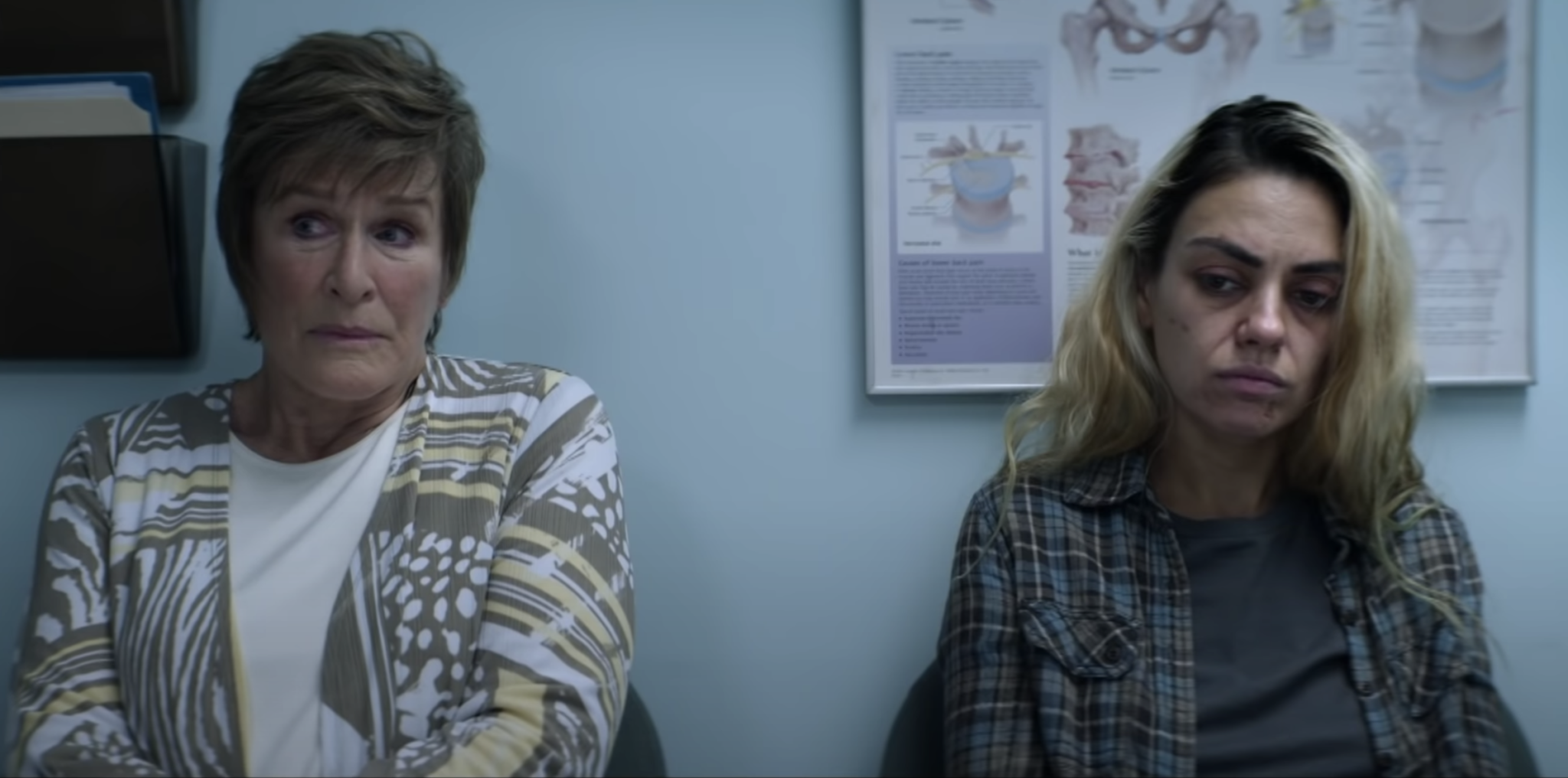“I’m going to level with you Molly—opioids have a 97 percent relapse rate.”
This is the opening line for the trailer to Four Good Days, a movie about addiction recovery set to release this spring. It’s a telling choice of statistic, considering that it’s completely fabricated.
Even if we forgive the clumsy semantics and assume the silver-bearded doctor means to say the rate for people with opioid use disorder (OUD) is 97 percent, we still have to ask: What population is this referencing? What time frame? And under what, if any, treatment model?
We know people with OUD can have very good outcomes when they have reliable access to methadone or buprenorphine—certainly much higher than 3 percent. While other methods like forced abstinence and detox have a comparatively high failure rate, that shouldn’t factor into the math for someone voluntarily seeking treatment.
But judging by the trailer, that’s only the beginning of the movie’s reliance on stigmatizing hyperbole to depict opioid addiction and recovery.
As the doctor speaks, the camera pans over to the pair sitting in his office. Many viewers will easily identify Glenn Close, but Mila Kunis, playing Close’s daughter Molly, is almost unrecognizable. She’s skeletal, with sunken cheeks and bleach-fried hair. Her scab-covered face is pallid except for dark red circles around her eyes. When she opens her mouth to ask the doctor whether the medication he’s prescribing—naltrexone—is safe, we get a strategic glimpse of missing and rotted teeth.
The film has already been dubbed a “sensitive addiction drama” that would “compassionately approach and strive to understand both addicts, and those who love them.”
“It is really fun to do something so outside the norm,” Kunis told Deadline. “When you go see the best special effects guy, who makes the most beautiful meth teeth, it sounds so weird to say, but you put it on, and you’re like, ‘Well, this is fun to play with.’ Then, you have to be able to teach yourself to speak with this mouth, and not sound like you’re lisping,”
Kunis, who nonetheless lisps her way through the trailer and appears to struggle to close her mouth, has inadvertently identified one of the film’s myriad false and problematic tropes: “Meth teeth,” which as many actual users of meth could tell you is an inaccurate stereotype.
Tooth decay is popularly associated with both methamphetamine and the prescription medication for opioid use disorder (MOUD) methadone. But in reality, dental issues arise from lack of access to dental care—one of many side effects of being poor in the United States. Maybe we should be calling it “lack of access to socialized health care mouth.”
“That’s the part that irritated me the most out of all of this, because I have messed up teeth,” said Megan, a video game tester from Oceanside, California, who asked to be identified by their first name only.
Megan is in methadone-based recovery from opioid addiction, but doesn’t attribute their tooth decay to drug use. “It’s from genetics and depression and poor self-care during depressive periods,” she said. “[Kunis] is saying she’s having fun putting on ‘meth teeth,’ but she can take them off. It’s not fun. It sucks, [and] it sucks to hear someone make jokes about that.”
“The people that come into the methadone clinic where I go, they all look like they’re ready to go to work.”
Like Kunis’s words, her character’s appearance displays a lack of empathy for the very population of whom she is supposedly providing a compassionate view. Variety described her appearance as a “gruesome vision” and a “living-dead specimen.” That’s not actually what most people who use drugs look like—even those whose use is chaotic.
“The people that come into the methadone clinic where I go, they all look like they’re ready to go to work, even the ones that are there to get their first dose,” Megan said. “Some of them may look a little tired because it’s early in the morning, but it’s very rare to see anyone that looks like they are coming out [of] a zombie movie.”
Four Good Days is based on a true story, detailed in a 2016 Washington Post article with a mixture of vivid narration and stigmatizing language. That article included photos of the real person, Amanda, whom Kunis portrayed in the movie. But in the photos, Amanda looks nothing like her cinematic counterpart.
She’s not emaciated. Her hair is long and lustrous. We don’t see her teeth, but her skin is clear. If the photos hadn’t accompanied an article about her struggles with recovery, they wouldn’t overtly suggest she used drugs at all, apart from cigarettes.
The conflation of drug users with “zombies” fuels a long-standing stereotype that people who use drugs are incapable of self-agency. That they are half-dead, self-harming monsters who lie and steal and manipulate to get their next fix—the only thing they care about. That this behavior is why they need to be locked away in prison, or at least rehab, and why their children need to be taken away.
Of course, there are people who use drugs whose behaviors are problematic. That’s also true of plenty of people who don’t use drugs. When we continuously see images of people who use drugs and people with substance use disorders that show them exclusively as the worst possible specimens of humanity, we forget that people who use drugs are everywhere, and of no better or worse character than anyone else.
A Problematic Focus on Naltrexone
It is egregious and unethical that Four Good Days makes no mention of the existence of methadone or buprenorphine. The specific MOUD touted in the movie (though it never actually mentions it by name) is the least evidence-based of the three most commonly used in the United States: naltrexone (brand name Vivitrol).
Vivitrol is an opioid antagonist, delivered as an injection that lasts about a month. Induction protocols usually involve giving patients a shorter-acting naltrexone tablet to ensure they don’t have a negative reaction, but once the shot goes in, patients can’t undo it—even if they change their mind, or become injured enough to need opioids for pain relief. It works by blocking the effects of other opioids—similar to buprenorphine, another MOUD with a more robust evidence base.
But unlike buprenorphine, naltrexone is not also an opioid agonist, meaning it does not help with cravings or withdrawal. And it requires at least a week of opioid abstinence before it can be used—hence the premise of the film, which takes place when Kunis’s character has four days until her induction.
Because of the high-barrier induction requirements, naltrexone can be more difficult to begin using than methadone or buprenorphine. People who use naltrexone can—and do—still overdose if they attempt to circumvent its blocking effects, or if they use again after its effects wear off.
In 2019, the Food and Drug Administration issued a warning letter to Alkermes, the manufacturer of Vivitrol, for failing to adequately inform the public about the overdose risk associated with the medication. It remains the MOUD of choice for law enforcement and criminal justice programs, including correctional facilities and drug courts.
“In the trailer, it was just so focused on Vivitrol [and] that makes me nervous,” said Rory O’Brien, the digital communications director at Students for Sensible Drug Policy. “It’s just more marketing for Vivitrol, and because it’s pitched as being ‘non-addictive,’ it’s going to be really appealing to, maybe not necessarily to people who want to stop using opioids, but [to] those parents watching it and people who are on the more paternalistic side.”
“There’s a lot of hesitancy for people of color to tell their stories—especially if they are still using drugs.”
Kunis’s character’s race and upbringing are highly relevant. Although Black people in the US are overdosing at higher rates than their white counterparts (despite both populations using at around the same rate), Black people and other people of color have markedly less access to evidence-based treatment. They are also disproportionately subject to incarceration and the foster system. But if we were to gauge our understanding of addiction and recovery solely by what we see on film, we would think it’s a white, middle-class problem.
Four Good Days exists because a white family impacted by addiction felt safe sharing their experience on a national platform. “There’s a lot of hesitancy for people of color to tell their stories—especially if they are still using drugs,” O’Brien said. “It’s a privilege to be able to tell your story. Some people just don’t have that ability because [their story] can be weaponized, especially … if you’ve been formerly incarcerated or if you have children.”
Photograph via YouTube





Show Comments